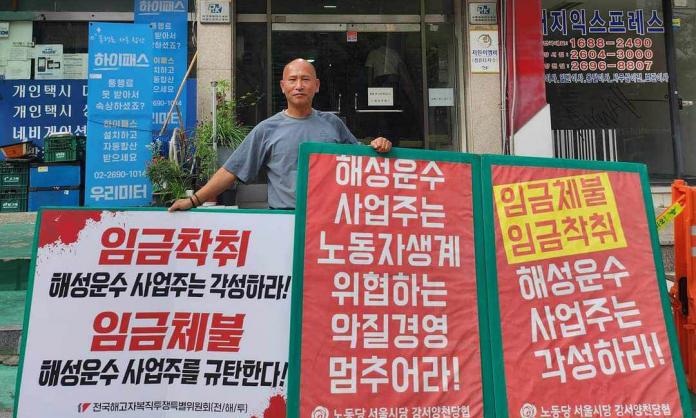The catastrophic impacts of the COVID-19 crisis are hitting some people harder than others. Migrant workers, economically precarious and living in appalling conditions with few legal rights, are particularly vulnerable to the medical dangers and financial hardships sweeping the globe.
For months, Singapore was lauded for its success in slowing the spread of the virus through strict social distancing and contact tracing. In early April, however, a new wave of COVID-19 hit the overcrowded dormitories housing migrant workers. With as many as 20 workers sharing a room and little basic health care, the dormitories created ideal conditions for the virus to spread. Social distancing is impossible when you’re sleeping stacked in bunk beds and sharing a bathroom and kitchen with hundreds of others.
The futuristic Singaporean cityscape has been constructed by highly exploited migrant labour. About 1.4 million foreign workers are currently in the city, coming primarily from South and South-East Asia on visas tied to their employers. Desperate for cash to send home to struggling families, and often having paid thousands of dollars to get to Singapore, they are easily taken advantage of by profit-hungry construction bosses. There is no minimum wage in the “dream city” of neoliberal capitalism.
Dormitories were quickly locked down after the initial surge in cases. This may have prevented transmission to other neighbourhoods, but it also sealed in the sick with the healthy. New cases across Singapore swelled beyond 1,000 a day, but only a handful of these were among citizens or permanent residents. The vast majority were migrant labourers, who make up roughly a quarter of the city’s population.
For these workers, the danger of contracting COVID-19 has to be weighed against the devastating loss of income that has accompanied the shutdown of industry. Families living in abject poverty rely on remittances – cash transfers sent home by migrant workers. In Nepal, these amount to almost 30 percent of GDP. This is the financial pressure that compels millions to pack up and leave their loved ones for years on end and work in conditions likened to modern slavery.
Like Singapore, the oil-rich Gulf states are also heavily dependent on migrant workers. Since Qatar was awarded the right to host the 2022 soccer world cup, a construction boom has drawn a million migrant workers to the country. They now make up 95 percent of the nation’s workforce. The pay is low, conditions are gruelling, and legal protections are minimal.
Every year, hundreds of workers die from heat stress from labouring for upwards of 10 hours a day in the searing desert sun, a form of industrial mass murder. Wages are often withheld for months, and living conditions are cramped, dirty and soulless. Workers enter the country under the Kafala (sponsorship) system, which gives their boss extraordinary powers over them, including preventing them from finding other work for five years and even controlling their ability to leave the country. Visas are formally tied to employers, and passports are frequently confiscated by bosses on arrival.
These brutal, exploitative conditions existed before the deadly COVID-19 pandemic hit. Today, with construction having ground to a halt, there is no work, no pay and, for many, no way home. Across the Gulf, crowded neighbourhoods of tens of thousands have been locked down, raising fears they will become hotbeds of the disease. Amnesty International reported in April that hundreds of Nepali workers in Doha were rounded up, told they were being taken for testing, then crammed onto buses, thrown into detention and deported to Kathmandu. Most never received their final pay packets.
A Nepali worker interviewed by Amnesty International described the ordeal: “The jail was full of people. We were given one piece of bread each day, which was not enough. All the people were fed in a group, with food lying on plastic on the floor. Some were not able to snatch the food because of the crowds”. Such is the treatment of workers without whom the country’s economy would grind to a halt.
--------------------
Migrant labour is essential not only for the construction booms of Singapore and the Gulf states, but for much of global capitalist production. Each year, millions trek into unknown lands to eke out a precarious existence, fuelling capitalist industry around the world. The second-class status awarded to these workers, and the consequent breach of basic human dignities, are a disgrace. Legal systems that enshrine this practice, like Kafala, should be abolished.
Slave-like conditions for foreign workers extend well beyond the construction sites and into the homes of the middle and upper class. There are now, according to the International Labour Organisation, more than 11 million migrant domestic workers, of whom more than 70 percent are women. Many of these workers have had to leave their own children and elderly relatives to go and care for those of their wealthy employers.
In regular times the work is hard. Most work a six-day week, and reports of abuse are widespread. Right now, the work is even grimmer. Hong Kong is home to more than 400,000 migrant domestic workers, mostly hailing from Indonesia and the Philippines. Local women’s shelters and NGOs have raised alarm bells about the sudden change in working conditions. While the city avoided a full-scale lockdown, many families have adopted a de facto lockdown in their homes. This means no day off, round the clock duties, more people at home to care for and heightened risk of abuse. Conditions are similar for the millions of domestic workers spread across North America, Western Europe and the Middle East.
Now, months into the COVID-19 crisis, lockdowns are starting to ease. This could invite further suffering for migrant workers and disaster for their countries of origin. As summer approaches in Western Europe, agricultural crops are ripening and waiting to be harvested. The low-wage, short-term employment model of European agriculture would fall apart without thousands of workers travelling from Bulgaria, Romania and the Ukraine each summer. In the UK, 98 percent of all farm workers are temporary migrants, and almost 300,000 fly in to Germany every year. In fact, these workers are deemed so essential that strict travel restrictions and lockdown orders have been waived to allow their passage.
There have already been casualties. In early April, a 57-year-old Romanian man was found dead in the German state of Baden-Württemberg after contracting COVID-19 while harvesting asparagus. Since then, Germany has flown thousands more workers into the country. The strict 14-day quarantine, which has been the norm for international travellers, has been replaced with a government ordered “de-facto quarantine with simultaneous work opportunity”, meaning work in the fields will begin upon arrival, and dorms will house six rather than the usual dozen.
While it’s understandable that economically precarious workers will seek work wherever they can find it, it’s irresponsible for governments to permit it under current conditions, and with little of even the most basic health precautions. There is a high risk of migrant workers living in cramped conditions catching the virus and a high danger of these workers spreading the virus when they return to their home countries. Profits, not concern for food security, are driving these dangers. The health of the economy is being prioritised over the health of seasonal workers.
--------------------
The United States has become the centre of the COVID-19 crisis, and its impacts have exposed the deep class and racial inequalities that thread the fabric of its society. There has been no let-up in Donald Trump’s relentless war on undocumented migrants and asylum seekers, even as the death toll has surged.
Frightening stories are filtering out of the border camps and detention centres. Tens of thousands of detainees are locked up in overcrowded and dilapidated prisons. Hand sanitiser, masks and gloves are nowhere to be seen – detainees must purchase their own soap in some places. People are still being bused around the country, mingling with those who have been exposed to COVID-19 and those who have not. It’s a humanitarian disaster waiting to happen.
Detainees have started to organise and protest, in whatever way they can. In March, a group of men launched a hunger and labour strike at the Stewart Detention Center in Georgia after 44 guards tested positive for COVID-19. A month later, two men at the Etowah County Detention Center climbed the internal rails of their prison and tied a noose made out of bed sheets around their necks, demanding not to be forced into lockdown with new inmates who showed signs of illness.
Karim Golding, the 35-year-old who initiated the protest, explained his motives in an interview with the Intercept. “We’re the last people to get protected”, he said. “If we die, so what? This is the attitude of the people here. This is the attitude of the attorney general. This is the attitude of the president. After all, burials are cheaper than deportations.”
The situation is no better at the border. Hundreds of additional troops were sent to the crossing zones in late March, creating new hot spots and clusters of COVID-19. Towns on the Mexican side of the border, now overflowing with migrants unable to cross or return home, are potential incubators of the virus. Two planes from El Paso and Brownsville in Texas flew 44 migrants with COVID-19 into Guatemala in April. With chartered flights increasing and reportedly few health checks for those boarding, the virus could spread across Central and South America into towns with high-density housing and no capacity to deal with a pandemic.
Undocumented migrants everywhere are now weighing up the cost of seeking medical help, which could potentially invite persecution from immigration authorities. As Malaysia lifted its lockdown in early May, three apartment blocks housing undocumented families were raided, and hundreds of migrants, including children as young as four, were thrown into detention. Just weeks earlier, the Malaysian defence minister assured them they faced no threat of persecution if they sought treatment when they were sick. Now he insists that anyone without documents will be detained and deported.
Migrants in Australia hold similar fears. More than a million people are on some form of temporary visa, with few rights and protections. They can’t access welfare payments. Agriculture, construction and health care industries all rely on migrant workers, many of whom have been, or are soon to be, forced into unemployment.
“The current situation is very upsetting for any migrant workers on temporary visas”, Lavanya Thavaraja, a community organiser with the Migrant Workers Centre in Victoria, tells Red Flag. “The government is not doing anything for them. Everyone on bridging visas can’t access Centrelink or any other community services. There’s no possibility for them to have any savings at all, so when the government says use your savings or go back to your countries, it’s not possible for them.”
An already precarious life, which Australia’s pre-existing migration laws have established, is likely to get worse, according to Lavanya. “These workers are at risk of going homeless. It’s terrible, these workers have been here maybe six, eight years”, she says. “All these years they worked and worked and worked and now they have nothing. But we are still fighting, we don’t have any option other than fighting with these workers.”
The COVID-19 crisis has exposed many ills of capitalist society, from poor health care systems to the blatant prioritisation of profit over human life. The exploitative, inhumane and callous treatment of migrant workers around the world is another. While immediate financial and health care protections should be established to help the more than 160 million foreign workers stuck in limbo around the world, a return to the status quo when the virus subsides is not enough. The inhuman conditions, meagre wages, and lack of rights and legal protections must end for good.










